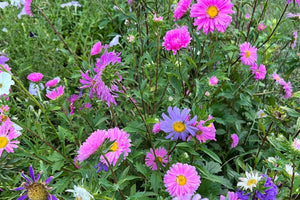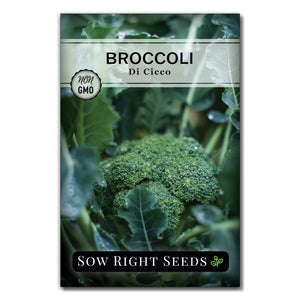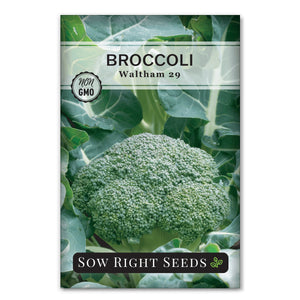How to Grow Broccoli: 4 Tips You Need to Know For the Best Home-Grown Broccoli
BroccoliBroccoli gets a lot of attention as an important vegetable for good reason. Broccoli has a high concentration of vitamins A, K, and C, along with fiber and folic acid. Studies have shown that eating broccoli can help prevent cancer and heart disease. It’s no wonder that home-grown broccoli is growing in popularity.
Growing broccoli from seed takes time, but the flavor is delicious, and with our helpful tips and tricks, you can successfully grow nutritious broccoli in your home garden.

Quick Links
Tips & Tricks for Your Best Home-Grown Broccoli
-
Temperature - Temperature is a vital element of successful broccoli growing. Broccoli seeds germinate at 75º, but once the seeds have sprouted and leaves are growing, broccoli will grow best in temperatures of 65º to 75º F. Knowing how hot your summer temperatures get and when will help you plan the optimal time for broccoli planting. Give your broccoli time to grow before it gets too hot. If you can’t get it started early enough in the spring, then grow broccoli in summer. You can sow seeds in July for a delicious fall harvest before a hard freeze.
-
Water - Water needs to be consistent to prevent stress that leads to bolting. When you first transplant, the tender seedlings will need daily watering. Broccoli has shallow roots, so use mulch to conserve water. Drip irrigation is a great way to keep moisture constant. An inch of water a week is usually sufficient.
-
Fabric covers - Even the bugs love broccoli. Using mesh fabric covers can protect plants from beetles and caterpillars. In addition, moths that lay eggs and other bugs can be kept off with floating row covers.
- Harvest - Harvesting at the right time will give you the best-tasting broccoli. When the florets on the broccoli head are tight and green with no yellow flowers, you will have the sweetest flavor.

How to Grow Broccoli From Seed
Growing broccoli from seed requires a little bit of a mind shift in when to plant and when to expect a harvest. Broccoli needs warmth to germinate but then cooler temperatures to grow.
Broccoli is a cool weather crop, unlike tomatoes and peppers that enjoy warm summer days. Therefore, temperature is a critical factor in the growth of broccoli. Our tips for germinating broccoli seeds, growing, and harvesting will help you be successful.
Broccoli Seed Germination
- Start seeds indoors about eight weeks before the last frost.
- In a damp seed starting mix, plant 3-4 broccoli seeds per pot or growing cell.
- Cover seeds with soil mix for a depth of 1/4”.
- Keep seeds moist until germination, which should take 7 - 14 days, depending on the broccoli variety.
- The optimum soil temperature for broccoli seed germination is 75º F.

Transplanting Broccoli Seedlings
Once your seedlings have at least two true leaves and are about 6 inches tall, it will be time to get them ready to transplant to the outdoor garden.
Transplanting at the right time is an essential tip for successfully growing broccoli. Smaller transplants usually do better with being moved and are more likely to form large heads. However, more mature plants are often disrupted by the transplanting process and are more likely to bolt and go to seed.
Harden off your seedlings to get them ready for their life outdoors.
When you place transplants in the garden, bury them 1 inch deeper than they were in their pots.
Once you transplant, you will have about 60 days until the broccoli is ready to harvest.

Growing Better Broccoli
Broccoli needs lots of space to grow larger heads. Plant seedlings 16 to 24 inches apart. You may notice smaller heads if they are planted closer together.
Three weeks after transplanting, apply extra fertilizer 5-10-15.
Broccoli needs to grow in a sunny location with at least 6 hours of sunlight each day.
Consistent watering will keep broccoli growing. Drip irrigation is a great way to get water to the roots while keeping the heads dry so they won’t rot.
Broccoli grows best in soil with a pH between 6 and 7.

When to Plant Broccoli
Broccoli is a cool-weather crop and can be planted in the spring or fall. Choosing when to plant broccoli will be based on when temperatures are at the optimal range.
The optimal temperature for growing broccoli is between 65º to 75ºF. However, it will bolt when the summer days are long and hot. This is why broccoli needs to be planted in early spring or late summer in many locations.
For many gardeners in the northern United States, February is the perfect time to start broccoli seeds indoors.
If it gets too hot and your broccoli goes to seed, try planting in late summer so it can grow in the cooler fall temperatures. The broccoli will need about three months to mature before the first hard freeze.
Start seeds indoors for spring transplanting and try direct sowing in the summer for a fall harvest of broccoli.
Broccoli can handle a light frost in fall and will even taste sweeter.

When to Harvest Broccoli
Broccoli takes 70 to 100 days to grow to maturity from seed. Once you have transplanted your seedlings, you can expect to harvest broccoli in 50 to 60 days, depending on the variety.
Broccoli tastes better when you harvest at an early stage before the flowers open. Harvest when the head is still tight without any yellow showing.
Using a sharp knife, cut at an angle 6 inches down the stem from the broccoli head.
Keep feeding and watering broccoli plants after harvesting the first head for a continual harvest of the side shoots. The side shoots will be smaller but still delicious.
For the best flavor and crispness, harvest in the cooler morning hours. Broccoli will stay fresh in a refrigerator for several days.
The Waltham variety will have heads about 5” wide. This is a good variety to grow in late summer for a fall harvest.
Di Cicco broccoli has many smaller heads instead of one big one. This variety works well in a spring garden.

Enjoying Your Home-Grown Broccoli
Growing your own broccoli means you can eat the leaves, side shoots, florets, and any other part of the plant. The leaves can be added to salads, smoothies, and anything else where you would use greens.
The stems can be shredded or diced to use in raw salads or cooked dishes.
The best way to cook broccoli is to steam it for 5 minutes. This method will preserve the most nutrients and give the best flavor.
To freeze broccoli, blanch it in boiling water for a few minutes.

Why should I grow broccoli from seed instead of transplants?
- Broccoli can be easily transplanted if it is still a young seedling. However, when you transplant larger plants, it can disrupt the roots and make the plant bolt or go to seed instead of developing a nice big head of broccoli. Transplants from a nursery may already be too big for successful transplanting.
- Growing from seed allows you to get broccoli into your garden at just the right time.
- You can plant a lot of broccoli from seed. There’s a considerable cost difference between growing broccoli from nursery plants vs. seeds.

How do I keep bugs off my broccoli?
There are a few pests that find broccoli as tasty as we do. Using fabric covers can help keep them off your plants.
Check broccoli plants frequently for caterpillars and aphids. Cabbage moths lay eggs on broccoli and cabbage. When they hatch, green caterpillars with white stripes will start eating the leaves.
You can use floating row covers to keep the moths off. If you find caterpillars or eggs, you can remove them by hand. Drop them in a bucket of soapy water and discard them away from the garden.
Once you find the right growing temperatures, you'll be amazed at how simple it is to grow broccoli from seed. Try growing this delicious and nutritious vegetable in your garden this year.
Written by Beverly Laudie









This is my first time trying this growth process. Any information, guidance would be greatly appreciated.
Leave a comment